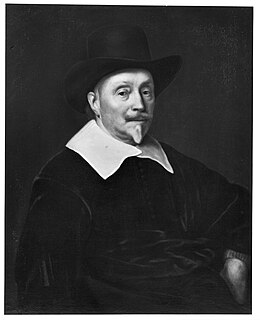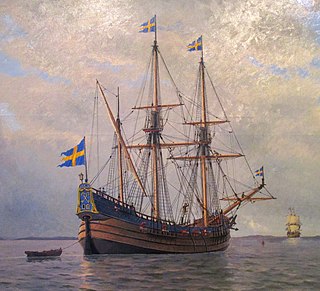| History | |
|---|---|
| | |
| Name | The Flying Deer |
| Fate | Lost with all hands in August 1638 |
TheFlying Deer (Dutch: Het fliegende hert) was a 17th-century Dutch ship. She was lost at sea with all hands during a hurricane off St. Kitts in 1638.
| History | |
|---|---|
| | |
| Name | The Flying Deer |
| Fate | Lost with all hands in August 1638 |
TheFlying Deer (Dutch: Het fliegende hert) was a 17th-century Dutch ship. She was lost at sea with all hands during a hurricane off St. Kitts in 1638.
The Flying Deer was an early 17th-century sloop in Dutch service. She was recorded as participating in the lucrative trans-Atlantic tobacco trade. In August 1638, the sloop was anchored off island of St. Kitts when the Swedish-flagged Kalmar Nyckel (which was returning from its first voyage to establish the colony of New Sweden) also dropped anchor off the island. [1] The captain of TheFlying Deer was a friend of Peter Minuit, a prominent explorer aboard the Swedish ship, and so Minuit and Captain Jan Hindricksen van der Water of Kalmar Nyckel were invited aboard The Flying Deer. During the visit, a powerful storm (possibly a hurricane) swept up on the island, battering the ships at anchor. Kalmar Nyckel rode out the storm at sea, but The Flying Deer was never seen again and presumed to be lost with all hands. [2] [3] [4]

New Sweden was a Swedish colony along the lower reaches of the Delaware River in America from 1638 to 1655, established during the Thirty Years' War when Sweden was a great military power. New Sweden formed part of the Swedish efforts to colonize the Americas. Settlements were established on both sides of the Delaware Valley in the region of Delaware, New Jersey, Maryland, and Pennsylvania, often in places where Swedish traders had been visiting since about 1610. Fort Christina in Wilmington, Delaware, was the first settlement, named after the reigning Swedish monarch. The settlers were Swedes, Finns, and a number of Dutch. New Sweden was conquered by the Dutch Republic in 1655 during the Second Northern War and incorporated into the Dutch colony of New Netherland.

Peter Minuit was from Tournai, in present-day Belgium. He was the 3rd Director of the Dutch North American colony of New Netherland from 1626 until 1631, and 3rd Governor of New Netherland. He founded the Swedish colony of New Sweden on the Delaware Peninsula in 1638.

Samuel Blommaert was a Flemish/Dutch merchant and director of the Dutch West India Company from 1622 to 1629 and again from 1636 to 1642. In the latter period, he was a paid commissioner of Sweden in the Netherlands and he played a dubious but key role in Peter Minuit's expedition that led to the Swedish colonizing of New Sweden. For years Blommaert was involved in the copper trade and industry. In 1645 he was appointed for a third time as a manager of the WIC, being one of the main investors from the beginning.

Fort Christina was the first Swedish settlement in North America and the principal settlement of the New Sweden colony. Built in 1638 and named after Queen Christina of Sweden, it was located approximately 1 mi (1.6 km) east of the present-day downtown Wilmington, Delaware, at the confluence of the Brandywine River and the Christina River, approximately 2 mi (3 km) upstream from the mouth of the Christina on the Delaware River.

The Great Hurricane of 1780, also known as Huracán San Calixto, the Great Hurricane of the Antilles, the Great Hurricane of the West Indies, and the 1780 Disaster, was the deadliest Atlantic hurricane on record. An estimated 22,000 people died throughout the Lesser Antilles when the storm passed through the islands from October 10 to October 16. Specifics on the hurricane's track and strength are unknown, as the official Atlantic hurricane database only goes back to 1851.

Delaware Colony in the North American Middle Colonies consisted of land on the west bank of the Delaware River Bay. In the early 17th century the area was inhabited by Lenape and possibly the Assateague tribes of Native Americans. The first European settlers were Swedes, who established the colony New Sweden at Fort Christina at present day Wilmington, in 1638. The Dutch captured the colony in 1655 and annexed it to New Netherland to the north. The English took control from the Dutch in 1664, and in 1682, William Penn, the Quaker Proprietor of Pennsylvania to the north, leased "the three lower counties on the Delaware River" from James, the Duke of York.

Kalmar Nyckel was a Swedish ship built by the Dutch famed for carrying Swedish settlers to North America in 1638, to establish the colony of New Sweden. The name Kalmar Nyckel comes from the Swedish city of Kalmar and nyckel meaning key in Swedish. The name was also a tribute to Kalmar Castle which was a symbol of power during the time of the Swedish Empire when Sweden was a military great power. A replica of the ship was launched at Wilmington, Delaware, in 1997.

RMS Rhone was a UK Royal Mail Ship owned by the Royal Mail Steam Packet Company (RMSP). She was wrecked off the coast of Salt Island in the British Virgin Islands on 29 October 1867 in a hurricane, killing 123 people. She is now a popular Caribbean wreck dive site.

Carroll A. Deering was a five-masted commercial schooner that was found run aground off Cape Hatteras, North Carolina in 1921 with the crew nowhere to be found. The Deering is one of the most written-about maritime mysteries in history, with claims that it was a victim of the Bermuda Triangle, though no evidence of paranormal or supernatural events aboard the ship has ever surfaced.

Swedes' Landing is the warehouse road found along the Minquas Kill in Wilmington, Delaware that is close to the Delaware River. This was the site where the initial Swedish landing took place and marks the spot where the New Sweden colony began. The first Swedish expedition to North America, under the command of Peter Minuit, embarked from the port of Gothenburg in late 1637. The members of the expedition, aboard the ships Fogel Grip and Kalmar Nyckel, sailed into Delaware Bay, which lay within the territory claimed by the Dutch West India Company and anchored at a rocky point on Swedes' Landing on March 29, 1638. They built a fort on the site which they named Fort Christina after Queen Christina of Sweden. Today Swedes Landing Road is a short stretch from 4th Street to 7th Street and ends at a long two-story mural depicting the area from the time before the Swedes came through the modern Wilmington waterfront. At the far end of the mural is the entrance to Fort Christina National Historical Site, a part of the First State National Historical Park System.

Swedish overseas colonies consisted of the overseas colonies controlled by Sweden. Sweden possessed overseas colonies from 1638 to 1663, in 1733 and from 1784 to 1878. Sweden possessed five colonies, four of which were short lived. The colonies spanned three continents: Africa, Asia and North America.

Reorus Torkillus (1608–1643) was priest of the Church of Sweden and the first Lutheran clergyman to settle in what would become the United States.
Måns Nilsson Kling or Mauno Kling was the second governor of the 17th century colony of New Sweden, which he administrated from Fort Christina, now Wilmington, Delaware.

HMS Centaur was a 74-gun third rate of the Royal Navy, launched on 14 March 1797 at Woolwich. She served as Sir Samuel Hood's flagship in the Leeward Islands and the Channel. During her 22-year career Centaur saw action in the Mediterranean, the Channel, the West Indies, and the Baltic, fighting the French, the Dutch, the Danes, and the Russians. She was broken up in 1819.
Quedagh Merchant, also known as the Cara Merchant and the Adventure Prize, was an Indian merchant vessel famously captured by Scottish privateer William Kidd on 30 January 1698.

HMS Investigator was the mercantile Fram, launched in 1795, which the Royal Navy purchased in 1798 and renamed HMS Xenophon, and then in 1801 converted to a survey ship under the name HMS Investigator. In 1802, under the command of Matthew Flinders, she was the first ship to circumnavigate Australia. The Navy sold her in 1810 and she returned to mercantile service under the name Xenophon. She was probably broken up c.1872.
Admiral Sir Lawrence William Halsted GCB was an officer of the Royal Navy who served during the American War of Independence and the French Revolutionary and Napoleonic Wars.
The Attack on Saint Martin was a failed attempt by the Dutch Republic to recapture the island and former base of the Dutch West India Company (WIC) from the Spanish. In 1633 the Spanish had invaded Saint-Martin and Anguilla, driving off the French and Dutch inhabitants. The French and Dutch banded together to repel the Spanish and it was during a 1644 sea battle that the Dutch commander Peter Stuyvesant, later the governor of New Amsterdam, unsuccessfully besieged Fort Amsterdam and was forced to retreat with the loss of hundreds of men. A stray Spanish cannonball shattered his leg, which had to be amputated. But luck was on the Dutch side, and when the Eighty Years' War between Spain and the Netherlands ended, the Spanish no longer needed a Caribbean base and just sailed away in 1648.
Fogel Grip was a Swedish sailing ship originally built in the Netherlands in the early 17th century. She was used on the first Swedish expedition in 1638 together with Kalmar Nyckel to establish the colony of New Sweden.
HMS Busy was launched in 1797 as the only member of her class of brig-sloops. She captured one French privateer and numerous small merchantmen, but spent most of her career escorting convoys to and from the West Indies. She foundered in 1807 while serving on the Halifax, Nova Scotia, station.